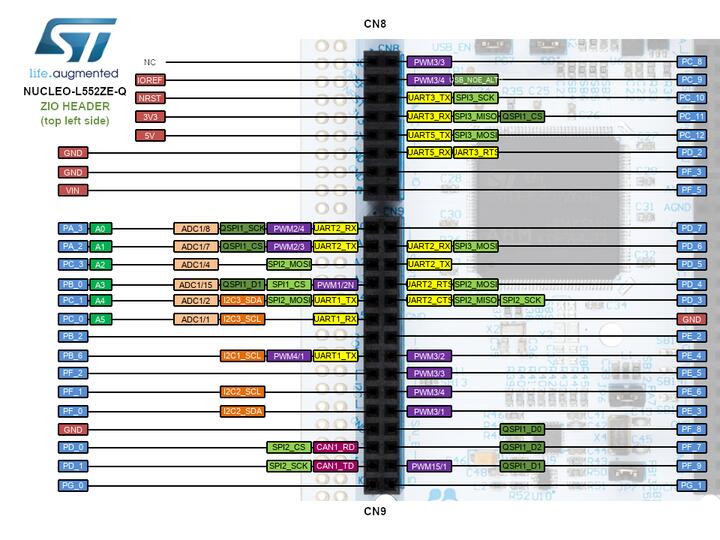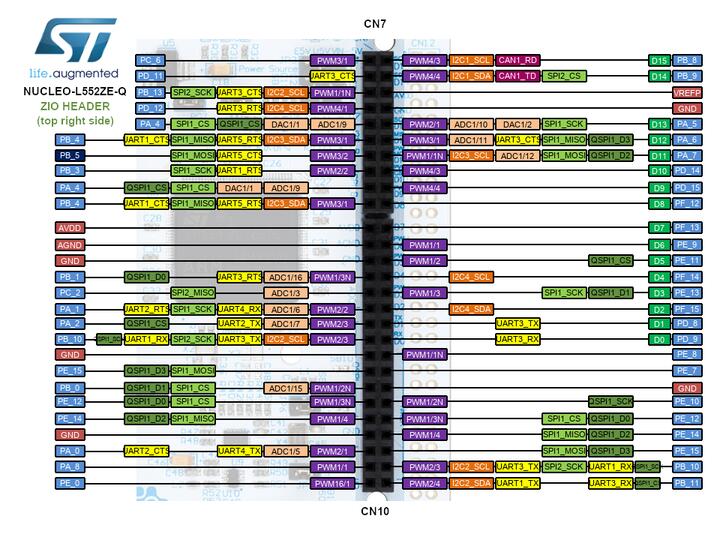ST Nucleo L552ZE Q
Overview
The Nucleo L552ZE Q board, featuring an ARM Cortex-M33 based STM32L552ZE MCU, provides an affordable and flexible way for users to try out new concepts and build prototypes by choosing from the various combinations of performance and power consumption features. Here are some highlights of the Nucleo L552ZE Q board:
STM32L552ZE microcontroller in LQFP144 package
Two types of extension resources:
Arduino Uno V3 connectivity
ST morpho extension pin headers for full access to all STM32 I/Os
On-board ST-LINK/V2-1 debugger/programmer with SWD connector
Flexible board power supply:
USB VBUS or external source(3.3V, 5V, 7 - 12V)
ST-Link
Three LEDs: USB communication (LD1), user LED (LD2), power LED (LD3)
Two push-buttons: USER and RESET
External or internal SMPS to generate Vcore logic supply
USB OTG full speed or device only

More information about the board can be found at the Nucleo L552ZE Q website.
Hardware
The STM32L552xx devices are an ultra-low-power microcontrollers family (STM32L5 Series) based on the high-performance Arm|reg| Cortex|reg|-M33 32-bit RISC core. They operate at a frequency of up to 110 MHz.
Ultra-low-power with FlexPowerControl (down to 108 nA Standby mode and 62 uA/MHz run mode)
Core: ARM® 32-bit Cortex® -M33 CPU with TrustZone® and FPU.
Performance benchmark:
1.5 DMPIS/MHz (Drystone 2.1)
442 CoreMark® (4.02 CoreMark® /MHZ)
Security
Arm® TrustZone® and securable I/Os memories and peripherals
Flexible life cycle scheme with RDP (readout protection)
Root of trust thanks to unique boot entry and hide protection area (HDP)
Secure Firmware Installation thanks to embedded Root Secure Services
Secure Firmware Update support with TF-M
HASH hardware accelerator
Active tamper and protection temperature, voltage and frequency attacks
True Random Number Generator NIST SP800-90B compliant
96-bit unique ID
512-byte One-Time Programmable for user data
Clock management:
4 to 48 MHz crystal oscillator
32 kHz crystal oscillator for RTC (LSE)
Internal 16 MHz factory-trimmed RC ( ±1%)
Internal low-power 32 kHz RC ( ±5%)
Internal multispeed 100 kHz to 48 MHz oscillator, auto-trimmed by LSE (better than ±0.25 % accuracy)
3 PLLs for system clock, USB, audio, ADC
Power management
Embedded regulator (LDO) with three configurable range output to supply the digital circuitry
Embedded SMPS step-down converter
External SMPS support
RTC with HW calendar, alarms and calibration
Up to 114 fast I/Os, most 5 V-tolerant, up to 14 I/Os with independent supply down to 1.08 V
Up to 22 capacitive sensing channels: support touchkey, linear and rotary touch sensors
Up to 16 timers and 2 watchdogs
2x 16-bit advanced motor-control
2x 32-bit and 5x 16-bit general purpose
2x 16-bit basic
3x low-power 16-bit timers (available in Stop mode)
2x watchdogs
2x SysTick timer
Memories
Up to 512 MB Flash, 2 banks read-while-write
512 KB of SRAM including 64 KB with hardware parity check
External memory interface for static memories supporting SRAM, PSRAM, NOR, NAND and FRAM memories
OCTOSPI memory interface
Rich analog peripherals (independent supply)
3x 12-bit ADC 5 MSPS, up to 16-bit with hardware oversampling, 200 uA/MSPS
2x 12-bit DAC, low-power sample and hold
2x operational amplifiers with built-in PGA
2x ultra-low-power comparators
4x digital filters for sigma delta modulator
19x communication interfaces
USB Type-C / USB power delivery controller
2.0 full-speed crystal less solution, LPM and BCD
2x SAIs (serial audio interface)
4x I2C FM+(1 Mbit/s), SMBus/PMBus
6x USARTs (ISO 7816, LIN, IrDA, modem)
3x SPIs (7x SPIs with USART and OCTOSPI in SPI mode)
1xFDCAN
1xSDMMC interface
2x 14 channel DMA controllers
CRC calculation unit
Development support: serial wire debug (SWD), JTAG, Embedded Trace Macrocell™
More information about STM32L552ZE can be found here:
Supported Features
The Zephyr nucleo_l552ze_q board configuration supports the following hardware features:
Interface |
Controller |
Driver/Component |
|---|---|---|
ADC |
on-chip |
ADC Controller |
CLOCK |
on-chip |
reset and clock control |
DAC |
on-chip |
DAC Controller |
DMA |
on-chip |
Direct Memory Access |
GPIO |
on-chip |
gpio |
I2C |
on-chip |
i2c |
NVIC |
on-chip |
nested vector interrupt controller |
PINMUX |
on-chip |
pinmux |
RNG |
on-chip |
entropy |
SPI |
on-chip |
spi |
TrustZone |
on-chip |
Trusted Firmware-M |
UART |
on-chip |
serial port-polling; serial port-interrupt |
die-temp |
on-chip |
die temperature sensor |
The default configuration can be found in the defconfig and dts files:
Common:
Secure target:
Non-Secure target:
Zephyr board options
The STM32L552e is an SoC with Cortex-M33 architecture. Zephyr provides support for building for both Secure and Non-Secure firmware.
The BOARD options are summarized below:
BOARD |
Description |
|---|---|
nucleo_l552ze_q |
For building Secure (or Secure-only) firmware |
nucleo_l552ze_q_ns |
For building Non-Secure firmware |
Here are the instructions to build Zephyr with a non-secure configuration, using tfm_ipc_ sample:
$ west build -b nucleo_l552ze_q_ns samples/tfm_integration/tfm_ipc/
Once done, before flashing, you need to first run a generated script that will set platform option bytes config and erase platform (among others, option bit TZEN will be set).
$ ./build/tfm/regression.sh $ west flash
Please note that, after having run a TFM sample on the board, you will need to run ./build/tfm/regression.sh once more to clean up the board from secure options and get back the platform back to a “normal” state and be able to run usual, non-TFM, binaries. Also note that, even then, TZEN will remain set, and you will need to use STM32CubeProgrammer to disable it fully, if required.
Connections and IOs
Nucleo L552ZE Q Board has 8 GPIO controllers. These controllers are responsible for pin muxing, input/output, pull-up, etc.
Available pins:


For more details please refer to STM32 Nucleo-144 board User Manual.
Default Zephyr Peripheral Mapping:
UART_1_TX : PA9
UART_1_RX : PA10
UART_2_TX : PA2
UART_2_RX : PA3
UART_3_TX : PD8
UART_3_RX : PD9
I2C_1_SCL : PB6
I2C_1_SDA : PB7
SPI_1_NSS : PA4
SPI_1_SCK : PA5
SPI_1_MISO : PA6
SPI_1_MOSI : PA7
SPI_2_NSS : PB12
SPI_2_SCK : PB13
SPI_2_MISO : PB14
SPI_2_MOSI : PB15
SPI_3_NSS : PB12
SPI_3_SCK : PC10
SPI_3_MISO : PC11
SPI_3_MOSI : PC12
PWM_2_CH1 : PA0
USER_PB : PC13
LD2 : PB7
DAC1 : PA4
ADC1 : PC0
System Clock
Nucleo L552ZE Q System Clock could be driven by internal or external oscillator, as well as main PLL clock. By default System clock is driven by PLL clock at 110MHz, driven by 4MHz medium speed internal oscillator.
Serial Port
Nucleo L552ZE Q board has 6 U(S)ARTs. The Zephyr console output is assigned to UART2. Default settings are 115200 8N1.
Programming and Debugging
Applications for the nucleo_l552ze_q board configuration can be built and
flashed in the usual way (see Building an Application and
Run an Application for more details).
Flashing
Nucleo L552ZE Q board includes an ST-LINK/V2-1 embedded debug tool interface. Support can be enabled on pyocd by adding “pack” support with the following pyocd command:
$ pyocd pack --update
$ pyocd pack --install stm32l552ze
Alternatively, this interface is supported by the openocd version included in the Zephyr SDK since v0.13.1.
Flashing an application to Nucleo L552ZE Q
Connect the Nucleo L552ZE Q to your host computer using the USB port. Then build and flash an application. Here is an example for the Hello World application.
Run a serial host program to connect with your Nucleo board:
$ minicom -D /dev/ttyACM0
Then build and flash the application.
# From the root of the zephyr repository
west build -b nucleo_l552ze_q samples/hello_world
west flash
You should see the following message on the console:
Hello World! arm
Building a secure/non-secure with Arm® TrustZone®
The TF-M integration sample TF-M IPC can be run on a ST Nucleo L552ZE Q.
In TF-M configuration, Zephyr is run on the non-secure domain. A non-secure image
can be generated using nucleo_l552ze_q_ns as build target.
$ west build -b nucleo_l552ze_q_ns path/to/source/directory
Note: When building the *_ns image with TF-M, build/tfm/api_ns/postbuild.sh bash script
is run automatically in a post-build step to make some required flash layout changes.
Once the build is completed, run the following script to initialize the option bytes.
$ build/tfm/regression.sh
Finally, to flash the board, run:
$ west flash
Note: Check the build/tfm directory to ensure that the commands required by these scripts
(readlink, etc.) are available on your system. Please also check STM32_Programmer_CLI
(which is used for initialization) is available in the PATH.
Debugging
You can debug an application in the usual way. Here is an example for the Hello World application.
# From the root of the zephyr repository
west build -b nucleo_l552ze_q samples/hello_world
west debug
